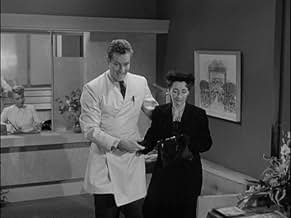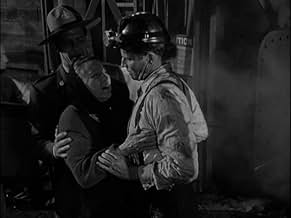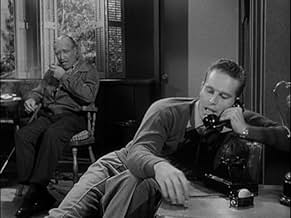IMDb रेटिंग
5.8/10
1.1 हज़ार
आपकी रेटिंग
अपनी भाषा में प्लॉट जोड़ेंA doctor returning from the Korean War to his hometown in Pennsylvania must choose what next to do with his life.A doctor returning from the Korean War to his hometown in Pennsylvania must choose what next to do with his life.A doctor returning from the Korean War to his hometown in Pennsylvania must choose what next to do with his life.
Philip Ahlm
- Minor Role
- (बिना क्रेडिट के)
Elsie Baker
- Mrs. Olzoneski
- (बिना क्रेडिट के)
Mary Benoit
- Party Guest
- (बिना क्रेडिट के)
फ़ीचर्ड समीक्षाएं
Charlton Heston and Lizabeth Scott are "Bad for Each Other" in this predictable 1953 film, also starring Mildred Dunnock, Arthur Franz, Marjorie Rambeau, and Dianne Foster.
Heston plays a doctor who returns from the service to the coal town where he grew up. After meeting the wealthy, twice-married, shallow Scott, he decides not to stay in the service and becomes a society doctor, in it for the money. The nurse he hires to work for him (Foster) thinks he's better than that.
The role played by Arthur Franz, that of a young doctor who admires him and doesn't mind going into the trenches, is essentially Heston's conscience.
I found this film pretty bland, but the big problem for me was that the main character as portrayed by Heston was just not likable. He wasn't likable before he took up with Scott nor was he likable throughout the film. Some of this was in the script, but some of it was in his line readings. He had fat attitude every time he opened his mouth. Frankly I didn't care what he did.
Lizabeth Scott was best earlier in her career, in her noir days, where her great voice, sexy blond looks, and ambiguous performances fit very well. Her character in this also was annoying. Now, she's not supposed to be likable, but we should have been able to see why Heston liked her. She seemed awfully pushy for his character to have put up with her.
Heston was tall, handsome, with a great voice and a dominating presence. This film was unfortunately directed in a somewhat old-fashioned manner so as to seem melodramatic and over the top. When someone with that strong a screen persona is directed that way, his performance becomes too actor-y.
Nothing special.
Heston plays a doctor who returns from the service to the coal town where he grew up. After meeting the wealthy, twice-married, shallow Scott, he decides not to stay in the service and becomes a society doctor, in it for the money. The nurse he hires to work for him (Foster) thinks he's better than that.
The role played by Arthur Franz, that of a young doctor who admires him and doesn't mind going into the trenches, is essentially Heston's conscience.
I found this film pretty bland, but the big problem for me was that the main character as portrayed by Heston was just not likable. He wasn't likable before he took up with Scott nor was he likable throughout the film. Some of this was in the script, but some of it was in his line readings. He had fat attitude every time he opened his mouth. Frankly I didn't care what he did.
Lizabeth Scott was best earlier in her career, in her noir days, where her great voice, sexy blond looks, and ambiguous performances fit very well. Her character in this also was annoying. Now, she's not supposed to be likable, but we should have been able to see why Heston liked her. She seemed awfully pushy for his character to have put up with her.
Heston was tall, handsome, with a great voice and a dominating presence. This film was unfortunately directed in a somewhat old-fashioned manner so as to seem melodramatic and over the top. When someone with that strong a screen persona is directed that way, his performance becomes too actor-y.
Nothing special.
Maybe if John Garfield had been cast instead of Charlton Heston (who looks and moves like Frankinstein's monster here); and if the producers (writers? director?) had not backed away from the mine safety, health, and company criminal negligence theme that packs a punch in the first ten minutes of the movie.
Bad for Each Other ([BFEO) is an obscure modestly regarded film that Charlton Heston made as a Paramount contract employee on loan out to Columbia at the dawn of his cinematic acting career. It was preceded by his excellent western movie Arrowhead, and immediately followed by his well regarded unusual adventure film The Naked Jungle (all made in 1953). BFEO (unlike Arrowhead and The Naked Jungle) is a contemporary social melodrama with a story set in a coal mining suburb of Pittsburgh. Heston is a recently discharged MD who is faced with the usual dilemma such folks often have to deal with: should he be a capitalist and seek out the most lucrative opportunity to practice medicine or a humanitarian and apply his skills to help the less fortunate people in his community? This is the issue at the heart of BFEO.
Heston is conflicted and somewhat self-righteous as he comes to grips with his personal values and convictions. Complicating matters are those individuals who are the major influences in his life: a predatory society woman who has set her sights on him (Lizabeth Scott), an idealistic nurse (Dianne Foster), a young doctor who believes that fulfillment can only come from assisting the poor (Arthur Franz), an older doctor who has a small practice in the mining community (Rhys Williams) and a.mother who believes that he should stay and work in his home town (Mildred Dunnock).
BFEO has a plot that contains echoes from other films: So Big (1932), The Citadel (1938), Not as a Stranger (1955), How Green Was My Valley (1941) and The Best Years of Our Lives (1948). It was directed in workmanlike fashion by veteran Irving Rapper, and the acting is consistently interesting. Heston is sincere, stalwart and occasionally naive in his troubled soul-searching, Scott (cast against type) is a spirited if not entirely credible rich young matron, Foster is a beautiful and appealing supporting player, Franz (a successful TV actor at the time) is quite engaging in his idealistic role, Williams is strong and dependable as always and Dunnock makes a most realistic mother trying to help her son with his choices in life. This excellent cast lifts BFEO from being a routine somewhat derivative entertainment, and the film certainly deserves a fresh reconsideration by a modern audience.
Heston is conflicted and somewhat self-righteous as he comes to grips with his personal values and convictions. Complicating matters are those individuals who are the major influences in his life: a predatory society woman who has set her sights on him (Lizabeth Scott), an idealistic nurse (Dianne Foster), a young doctor who believes that fulfillment can only come from assisting the poor (Arthur Franz), an older doctor who has a small practice in the mining community (Rhys Williams) and a.mother who believes that he should stay and work in his home town (Mildred Dunnock).
BFEO has a plot that contains echoes from other films: So Big (1932), The Citadel (1938), Not as a Stranger (1955), How Green Was My Valley (1941) and The Best Years of Our Lives (1948). It was directed in workmanlike fashion by veteran Irving Rapper, and the acting is consistently interesting. Heston is sincere, stalwart and occasionally naive in his troubled soul-searching, Scott (cast against type) is a spirited if not entirely credible rich young matron, Foster is a beautiful and appealing supporting player, Franz (a successful TV actor at the time) is quite engaging in his idealistic role, Williams is strong and dependable as always and Dunnock makes a most realistic mother trying to help her son with his choices in life. This excellent cast lifts BFEO from being a routine somewhat derivative entertainment, and the film certainly deserves a fresh reconsideration by a modern audience.
Charlton Heston stars as doctor and retired Army colonel Tom Owen. He has returned to his home turf, the small mining town of Coalville. The miners hate him because of something his now-dead brother did years earlier, but the upper crust of Coalville society are excited by the new hunky doctor's arrival. With the help of rich man-eater Helen (Lizabeth Scott), Tom is soon in private practice, catering to the lonely and wealthy women of Coalville. His nurse Joan (Dianne Foster) wants to practice the "right kind of medicine", but is Tom only interested in a fast buck and a good time?
This was just terrible, badly written and even more poorly acted. Heston wins the prize for "Worst in Show", delivering his lines in the most grating, hammy way imaginable, while also exhibiting some of the most overwrought physical business I've ever seen on the screen. The script never fails to tell you how wonderful Heston's Tom Mason is supposed to be, even if we are given scant evidence of it. Every woman falls at his feet, while every man is either in awe or angry with jealousy. Some may enjoy how the movie moves from just bad to amusingly camp, while others will just hit the "stop" button and find something better to do with their remaining time.
This was just terrible, badly written and even more poorly acted. Heston wins the prize for "Worst in Show", delivering his lines in the most grating, hammy way imaginable, while also exhibiting some of the most overwrought physical business I've ever seen on the screen. The script never fails to tell you how wonderful Heston's Tom Mason is supposed to be, even if we are given scant evidence of it. Every woman falls at his feet, while every man is either in awe or angry with jealousy. Some may enjoy how the movie moves from just bad to amusingly camp, while others will just hit the "stop" button and find something better to do with their remaining time.
A freshly discharged army doctor passes up practice in blue-collar hometown for big- paying practice among a city elite that includes a cool blonde dilettante.
I got this epic as part of a package claiming to be all noir. The only thing noir in this movie are the several night time shots— otherwise, no crime, no hand of fate, and no moody atmosphere. Only blonde seductress Helen (Scott) instead, and she's hardly the standard spider woman. Actually, the movie's more b&w soap opera than anything else.
That's not to say there're no redeeming features. I guess I wasn't aware of what a racket doctoring among the wealthy can be. The movie shows what a cushy pandering job it can be, treating headaches with high-priced medicines and smarmy words. And coming from a muckraker like novelist McCoy, e.g. They Shoot Horses Don't They (1969), I take it as factually based.
And surprise, surprise, to me, at least—actor Heston is quite animated as the sell-out doctor. I guess this was before he stiffened into a big-screen movie god, but whatever, he's quite persuasive in the role. Still, I thought the script made the doc's transition from honorable soldier to money-grubbing pill pusher much too easy, more like a movie device than a character change. Nonetheless, get a load of the coal mine scenes, quite realistic and well done.
But, bottom line, the story follows a familiar pattern with no surprises, suggesting a production serving mainly as a vehicle for Columbia's newest hunk.
I got this epic as part of a package claiming to be all noir. The only thing noir in this movie are the several night time shots— otherwise, no crime, no hand of fate, and no moody atmosphere. Only blonde seductress Helen (Scott) instead, and she's hardly the standard spider woman. Actually, the movie's more b&w soap opera than anything else.
That's not to say there're no redeeming features. I guess I wasn't aware of what a racket doctoring among the wealthy can be. The movie shows what a cushy pandering job it can be, treating headaches with high-priced medicines and smarmy words. And coming from a muckraker like novelist McCoy, e.g. They Shoot Horses Don't They (1969), I take it as factually based.
And surprise, surprise, to me, at least—actor Heston is quite animated as the sell-out doctor. I guess this was before he stiffened into a big-screen movie god, but whatever, he's quite persuasive in the role. Still, I thought the script made the doc's transition from honorable soldier to money-grubbing pill pusher much too easy, more like a movie device than a character change. Nonetheless, get a load of the coal mine scenes, quite realistic and well done.
But, bottom line, the story follows a familiar pattern with no surprises, suggesting a production serving mainly as a vehicle for Columbia's newest hunk.
क्या आपको पता है
- ट्रिवियाAccording to December 1950 articles in The Hollywood Reporter and the Los Angeles Times, producer Hal B. Wallis purchased the rights to the novel before it was published for $100,000 ($1.3M in 2024). Wallis intended the leads to be Burt Lancaster and Patricia Neal and that the project was to be filmed at Paramount. It never got off the ground, and Wallis ended up selling the rights to Columbia in early 1953.
- गूफ़The beginning scenes of movie show coal mine operations in Coalville, PA. The railroad caboose was from ATSF (Atchison, Topeka, and Santa Fe). That railroad never had operations in Pennsylvania.
- भाव
Dr. Tom Owen: [on the phone with his wife] Oh, I'm interviewing nurses, of course... Don't be silly, darling - of course she'll be fat and ugly. I do insist on good legs, though.
टॉप पसंद
रेटिंग देने के लिए साइन-इन करें और वैयक्तिकृत सुझावों के लिए वॉचलिस्ट करें
- How long is Bad for Each Other?Alexa द्वारा संचालित
विवरण
- चलने की अवधि
- 1 घं 23 मि(83 min)
- रंग
इस पेज में योगदान दें
किसी बदलाव का सुझाव दें या अनुपलब्ध कॉन्टेंट जोड़ें





































